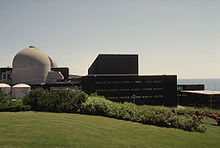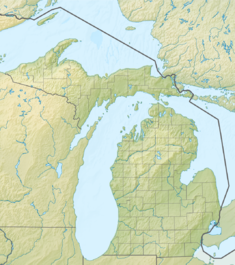Donald C. Cook Nuclear Generating Station
| Donald C. Cook Nuclear Plant | |
|---|---|

Plant as seen from visitors section looking towards Unit 1 and the steam turbine building
|
|
| Country | United States |
| Location | Lake Township, Berrien County, near Bridgman, Michigan |
| Coordinates | 41°58′31″N 86°33′57″W / 41.975391°N 86.565914°WCoordinates: 41°58′31″N 86°33′57″W / 41.975391°N 86.565914°W |
| Status | Operational |
| Construction cost | $3.352 billion (2007 USD) |
| Owner(s) | American Electric Power |
| Operator(s) | Indiana Michigan Power Company |
| Power generation | |
| Nameplate capacity | Unit 1: 1,048 MW Unit 2: 1,107 MW |
| Website Cook Nuclear Plant |
|
Donald C. Cook Nuclear Plant is a nuclear power plant located just north of the city of Bridgman, Michigan which is part of Berrien County, on a 650-acre (260 ha) site 11 miles south of St. Joseph, Michigan, USA. The plant is owned by American Electric Power (AEP) and operated by Indiana Michigan Power, an AEP subsidiary. It has two nuclear reactors and is currently the company's only nuclear power plant.
The construction cost of the power plant was $3.352 billion (2007 USD).[1] The plant produces 2.2 GW of electricity, enough to meet the needs of a city with 1.25 million people.
The plant is connected to the power grid via one 765 kV line that goes from the plant to AEP's DuMont substation near Lakeville, Indiana and by numerous 345 kV lines, two of which interconnect with Consumers Energy/METC, connecting with the Palisades Nuclear Generating Station, owned by Entergy.
Contents
License expiration and renewal[edit]
The US Nuclear Regulatory Commission renewed the operating licenses of both reactors on August 30, 2005. With the renewal, Unit One's operating license will expire in 2034 while Unit Two's will expire in 2037.[2] The units were initially licensed for forty years from their operational date.
Surrounding population[edit]
The Nuclear Regulatory Commission defines two emergency planning zones around nuclear power plants: a plume exposure pathway zone with a radius of 10 miles (16 km), concerned primarily with exposure to, and inhalation of, airborne radioactive contamination, and an ingestion pathway zone of about 50 miles (80 km), concerned primarily with ingestion of food and liquid contaminated by radioactivity.[3]
The 2010 U.S. population within 10 miles (16 km) of D.C. Cook was 54,638, an increase of 3.4 percent in a decade, according to an analysis of U.S. Census data for msnbc.com. The 2010 U.S. population within 50 miles (80 km) was 1,225,096, an increase of 2.8 percent since 2000. Cities within 50 miles include South Bend, IN (26 miles to city center), Michigan City, IN, St. Joseph, MI, and Kalamazoo, MI.[4]
Visitors center[edit]
The plant has a visitors center that was open to the public six days a week on a drop in basis. Since the attacks of September 11, however, the plant is open only to school groups by reservation. The visitors center features a 26-foot (7.9 m) animated model demonstrating how the plant operates.
Ownership[edit]
The plant is operated by the Indiana Michigan Power Company and owned by American Electric Power.
Incidents[edit]
- In 1976 two workers were killed in a recirculation pit (sump) by asphyxiation from argon inerting gas used to support welding on stainless steel piping.[5]
- July 13, 1990 one person was killed by electrocution and three others suffered severe burn injuries from a 4kv switchgear explosion.
- In September, 1997, both units were shut down for approximately three years when, as a result of NRC inspections in the engineering area, it became unclear whether emergency core cooling systems could perform their intended functions in the event of a design basis accident. [6]
- In 1998 the NRC imposed a $500,000 civil penalty for 37 regulatory violations, mostly concerning the containment ice condenser used in responding to some loss-of-coolant accidents[7]
- On May 12, 2002, Unit 2 was automatically shut down due to the failure of both redundant DC power supplies in the Reactor Control & Instrumentation System. Due to inadequate corrective actions, the same event occurred on February 5, 2003.[8][9]
- A transformer fire caused an automatic shutdown of Unit 1 in 2003 and release of cooling oil to Lake Michigan.[10]
- A massive intrusion of fish caused both units to be manually shut down for several weeks on April 24, 2003. Due to the degradation in Essential Service Water flow to the plants' Emergency Diesel Generators, the site entered the Emergency Plan at the Alert level. The Alert was exited approximately 25 hours later.[11]
- On September 20, 2008 unit 1's main turbine and generator were damaged by severe turbine vibrations caused by broken low-pressure turbine blades.[12] A fire also broke out in the generator of Unit 1. No radiation was released and Unit 2 continued to operate at full power.[13][14]
Seismic risk[edit]
The Nuclear Regulatory Commission's estimate of the risk each year of an earthquake intense enough to cause core damage to the reactor at D.C. Cook was 1 in 83,333, according to an NRC study published in August 2010.[15][16]
Additional information[edit]
| Unit 1 | Unit 2 | |
|---|---|---|
| Reactor Type | Pressurized Water | Pressurized Water |
| Reactor Manufacturer | Westinghouse | Westinghouse |
| Turbine Manufacturer | General Electric | Brown Boveri |
| Generation Capacity | 1,020 megawatts | 1,090 megawatts |
| Transmission System Connection | 345,000 volts | 765,000 volts |
| Construction Began | March 1, 1969 | March 1, 1969 |
| Grid connection | February 10, 1975 | March 22, 1978 |
| Operational Date | August 27, 1975 | July 1, 1978 |
| Expiration of Original License | October 25, 2014 | December 23, 2017 |
| Expiration of Renewed License | 2034 | 2037 |
References[edit]
- ^ "State Nuclear Profiles - Energy Information Administration".
- ^ "AEP - News Releases - AEP's Cook Nuclear Plant operating licenses extended 20 years by NRC".
- ^ NRC: Backgrounder on Emergency Preparedness at Nuclear Power Plants Archived October 2, 2006, at the Wayback Machine.
- ^ Bill Dedman, Nuclear neighbors: Population rises near US reactors, msnbc.com, April 14, 2011 http://www.msnbc.msn.com/id/42555888/ns/us_news-life/ Accessed May 1, 2011.
- ^ "NRC: Information Notice No. 85-87: Hazards of Inerting Atmospheres".
- ^ NRC doc: Tran-M119830: Briefing on D.C. Cook Nuclear Power Plant Public Meeting, November 30, 1998
- ^ Dave Lochbaum (23 August 2016). "UCS Causes Meltdowns at US Nuclear Reactors (no, really)". Union of Concerned Scientists. Retrieved 10 October 2016.
- ^ http://www.nrc.gov/NRR/OVERSIGHT/ASSESS/2002q4/cook2_pim.pdf
- ^ http://www.nrc.gov/NRR/OVERSIGHT/ASSESS/2003q2/cook2_pim.pdf
- ^ "AEP - News Releases - Transformer fire takes AEP's Cook Nuclear Plant Unit 1 off-line; site emergency plan briefly activated at lowest level".
- ^ http://www.nuclear.com/archive/2003/07/09/Cook_IR_315-03-08.pdf
- ^ "Cook 1 restart September at the earliest".
- ^ staff, 24 Hour News 8 web (25 September 2015). "ArtPrize Adventures: Heartside pub art crawl".
- ^ http://www.wwmt.com/articles/fire_1353659___article.html/power_nuclear.html[permanent dead link]
- ^ Bill Dedman, "What are the odds? US nuke plants ranked by quake risk," msnbc.com, March 17, 2011 http://www.msnbc.msn.com/id/42103936/ Accessed April 19, 2011.
- ^ http://msnbcmedia.msn.com/i/msnbc/Sections/NEWS/quake%20nrc%20risk%20estimates.pdf
External links[edit]
![]() Media related to Donald C. Cook Nuclear Generating Station at Wikimedia Commons
Media related to Donald C. Cook Nuclear Generating Station at Wikimedia Commons
- Aerial photos of the Cook plant
- Cook Nuclear Power Plant Page
- U.S. Nuclear Regulatory Commission Information Page for Unit 1
- U.S. Nuclear Regulatory Commission Information Page for Unit 2
